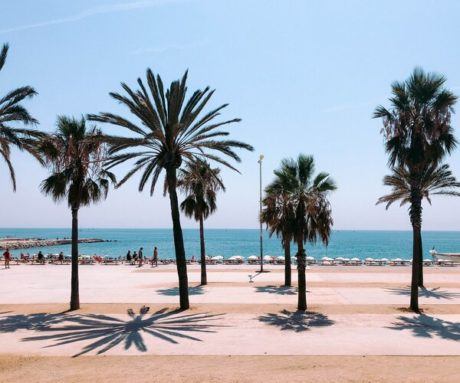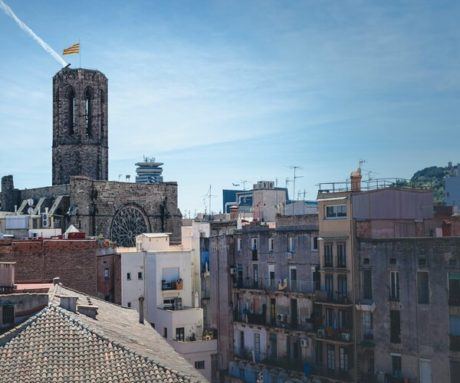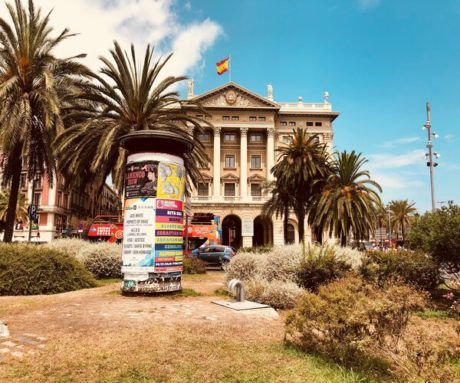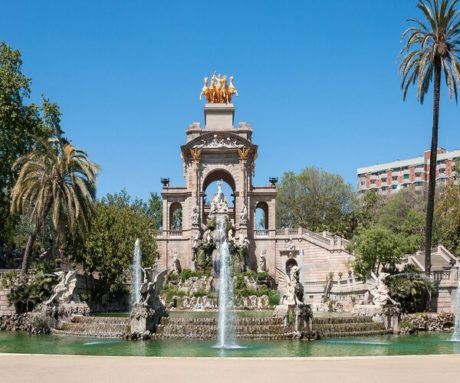Discover the Old Town of Barcelona

The first human settlements in Barcelona are believed to date back to the Neolithic period, with ruins of early settlers excavated in the El Raval neighborhood dating more than 5000 years ago. As a city, Barcelona was founded by the Romans around the end of the 1st century BC, with the original name of Barcino. Due to its strategic position between the Mediterranean Sea and the Collserola mountain ridge, Barcelona has always been a city of great importance since its inception through to the present day.
Ciutat Vella, meaning Old Town in English, was Barcelona’s first district that emerged from a walled precinct that surrounded the ancient city. Due to being the oldest part of the city, it is generally considered as the city’s center and remains a popular choice for both residents and tourists alike. Despite being the oldest district, it is one of the liveliest and most diverse areas of Barcelona, with the contrast of its winding streets and impressive Gothic architecture, against the bustling, contemporary restaurants, shops, and bars.
There are four neighborhoods that comprise the Ciutat Vella district: La Barceloneta, the Gothic Quarter, El Raval, and Sant Pere, Santa Caterina i la Ribera. Let’s explore each of these varied neighborhoods to get to know this fascinating area of Barcelona…
La Barceloneta
La Barceloneta of Ciutat Vella is the city’s beach neighborhood, bordered by the Mediterranean Sea, the Moll d’Espanya of Port Vell, and El Born. Barceloneta was constructed in the 18th century for residents of the Ribera that had been displaced by the creation of the Parc de la Ciutadella. Previously it was practically uninhabited, with only fishermen frequenting the area while working.
Today, it is known as the laid-back beach area of Barcelona, with its three beautiful beaches of Barceloneta, Sant Sebastià, and Somorrostro. Thanks to Barcelona’s warm Mediterranean climate, living in Barceloneta in the summer months gives you an enviable location allowing you to be the first one to arrive, and the last one to leave the city’s golden sands. There’s always an abundance of people exercising, dog walking, or simply relaxing by the shores here from sunrise to sunset. Another popular aspect of the neighborhood is its ‘chiringuitos’, meaning beach bars, that serve a variety of both traditional Catalan and international food and drinks.
Despite its relatively recent conception, La Barceloneta is far from lacking history and culture. The San Miguel del Puerto Church was constructed in 1753 in breathtaking classic baroque style, along with the Palau de Mar in 1880 which is home to the History Museum of Catalonia.

Gothic Quarter
The historic center of the Ciutat Vella, the Gothic Quarter stretches from La Rambla to Via Laietana, and from the seafront to Ronda de Sant Pere. The quarter contains some of the city’s oldest buildings, but much of the architecture you see today grew during the 19th and 20th centuries, as the city prepared its infrastructure for the Barcelona World Exposition in 1929. During this period many existing buildings were restored, and others were created with neo-Gothic features and structures, that continued as late as the 1960s.
There’s a plethora of landmarks and buildings that are iconic to the Gothic Quarter, including the Cathedral of Santa Eulàlia, the Church of Santa Maria del Pi, and the bridge that crosses Carrer Bisbe. The neighborhood also is home to some of the most iconic squares in the city, including the Plaça del Rei, Plaça Sant Jaume, and Plaça Reial. Here you can find numerous excellent restaurants and bars to have tapas and drinks with friends. Next to the Plaça Sant Jaume is the Generalitat de Catalonia, which makes this spot very important to the entire region of Catalonia. Both celebrations and manifestations are held here, with the traditional castellers (human towers) assembling here too during festivals!

El Raval
Formerly known as Barri Xinès, meaning Chinatown, El Raval borders La Rambla. The area earned its name, not because of a large Chinese population, but because it was how the creators imagined a Chinese city to be. It is home to around 50,000 people and is found to the west side of Ciutat Vella, stretching from Plaça Catalunya at the top, all the way down to the port in the south.
There are many notable sights in El Raval, one of the most recognizable to tourists being La Boquería market found on Las Ramblas. La Boquería is a huge food market full of fresh fruit, vegetables, spices, meats, and much more. Additionally, there is the Palau Güell, one of Antoni Gaudí’s first commissions built in 1888, which is now declared a UNESCO World Heritage Site that is open for visits from the public. There are two renowned museums worth visiting, the MACBA (Museum of Modern Art) and the CCCB (Centre of Contemporary Culture in Barcelona), that also call El Raval their home.
El Raval in the past has held a negative reputation as being a dangerous neighborhood in Barcelona, but since then the local government has invested in the area to rejuvenate and regenerate its image. Now, it is seen as one of the most dynamic and diverse areas of the city, that attracts international people and locals alike.

Sant Pere, Santa Caterina i la Ribera
This neighborhood is a mix of Sant Pere, Santa Caterina, and la Ribera, and is often now referred to as ‘El Born’. This area of Barcelona is found sandwiched between the Gothic Quarter and the Parc de la Ciutadella and stretches all the way up from Barceloneta to the Palau de la Música Catalana. Many early inhabitants of El Born were fishermen and dockworkers, being located so close to the sea, but over time the population began to incorporate noblemen and rich merchants who decided to construct their houses here.
Sant Pere, Santa Caterina i la Ribera is one of the most popular areas in Barcelona to live, thanks to its delightful fusion of authentic, historical Barcelona, with the vibrant buzz of the contemporary, thanks to its abundance of restaurants, bars, and cafés. Must-visit sights in this neighborhood include the iconic Palau de la Música Catalana, a UNESCO World Heritage Site concert hall built in the style of Catalan Art Nouveau, that puts on over 150 shows all year round. To learn more about one of Spain’s, and indeed the world’s, most famous artists, Pablo Picasso, a trip to the Picasso Museum in El Born is also a must. For a step into nature, the Parc de la Ciutadella sitting on the edge of the El Born is one of the most popular parks in all of Barcelona.
Legend says that the name used nowadays to describe the area, ‘El Born’, originates from the Catalan word ‘bornejar’, meaning to joust. During the medieval era, jousting tournaments were held on the strip that is now called Passeig del Born, which still to the present day is one of the neighborhood’s most lively streets.
By Sandra Roig
